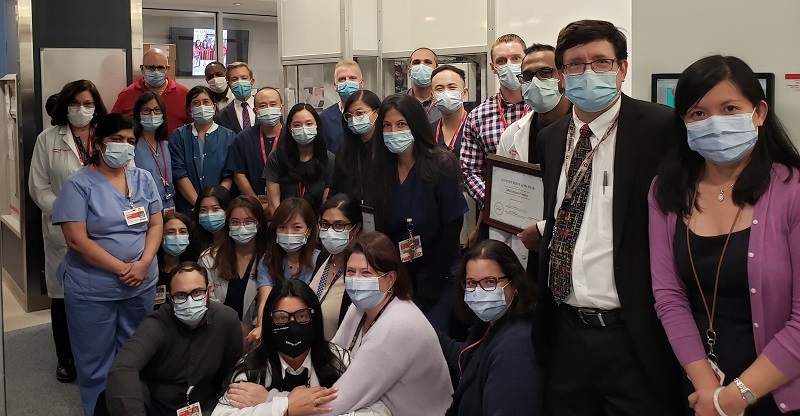NewYork-Presbyterian Queens (Flushing, NY) earned recognition as a finalist for ECRI's 14th Health Devices Achievement Award for the pharmacy department's well-conceived implementation of a gravimetric-based IV workflow management system. The new system has increased patient safety and made the department more efficient.
The Health Devices Achievement Award recognizes outstanding initiatives undertaken by member healthcare institutions to improve patient safety, reduce costs, or otherwise facilitate better strategic management of health technology. For details about the winning submission and other finalists, see
The Health Devices Achievement Award: Recognizing Exceptional Health Technology Management.
ECRI congratulates Katharine Cimmino, PharmD, along with the pharmacy team—including Jason Lee, PharmD; Melanie Boller; Jocelyn M. Catbagan; Andrew Ferri, PharmD; Jenny Kochupurackal, PharmD; Kevin Pettenon, PharmD; Kevin Wilkin; and Thomas Weigl—as well as the NewYork-Presbyterian IT department and other contributors to the interdisciplinary effort.
 NewYork-Presbyterian Queens. (Image courtesy of the hospital.)
NewYork-Presbyterian Queens. (Image courtesy of the hospital.) |
The Challenge
To improve pharmacy sterile compounding practices and enhance patient safety by implementing a gravimetric-based IV workflow management system (IVWMS).
The Context
NewYork-Presbyterian Queens has been on the path to building a state-of-the-art pharmacy department since 2012, when the facility was awarded a New York state grant for a complete, nonpunitive, on-site review from the Institute for Safe Medication Practices (ISMP). ISMP's review revealed enormous gaps in the 535-bed hospital's medication management system—gaps that could lead to medication errors. Hospital leadership responded by investing in projects that could help reduce errors and increase efficiency by automating the drug distribution processes that were prone to human error.
Through the addition of technology and increased automation, the facility progressed to the point where the pharmacy was distributing nearly all items through an automated bar-code process—approximately 89% of all doses, with compounded preparations accounting for much of the balance. These additions greatly decreased the chances of a dispensing error.
The one area where technology was lacking, however, was in the sterile compounding area. Standard pharmacy compounding is a complicated process that revolves around manual tasks, and thus poses patient safety risks. Potential errors include incorrect drug selection and the compounding of inaccurate medication doses.
The NewYork-Presbyterian Queens team determined that implementing a gravimetric IVWMS—a system that provides step-by-step workflow guidance and documentation of every compounding step—could help close the gaps in medication safety. The system integrates sterile compounding functions like bar-code scanning, image capture, and gravimetric analysis.
The Process
Seizing on the opportunity to prevent inadvertent patient harm, the NewYork-Presbyterian Queens pharmacy department led a patient safety initiative to adopt a gravimetric-based IVWMS. Gravimetric analysis provides quantitative quality assurance by objectively measuring mass rather than subjectively visualizing volume.
After securing funding for the project, pharmacy leadership and staff collaborated with the IT department to form an interdisciplinary team. The team established a timeline and stepped through the implementation process. Milestones included a kickoff meeting, interface build and testing, drug library build, validation, equipment setup, staff training (on-site), and go-live with four prep stations. The system included integration with high-risk compounding, such as for chemotherapy and neonatal/pediatric doses. The process was completed in seven months, with system upgrades and expansion to include all six compounding sites occurring over subsequent months.
The system's hard stops and system checks added steps to the compounding process, which led to initial reluctance among pharmacists in fully adopting the IVWMS technology. To overcome this reluctance, the team instituted additional training sessions, conducted with the help of the vendor, to educate users about the critical patient safety function of those features. Staff soon recognized that using the IVWMS technology actually streamlined the workflow, saving them time. The system provides step-by-step instructions, crucial information such as beyond-use dating and details about storage conditions, and in-depth documentation, which helps ensure compliance with Joint Commission and U.S. Pharmacopeia (USP) requirements.
Once the IVWMS was live, the pharmacy was able to use the system to gather metrics surrounding productivity, safety, and cost savings—all of which helped improve the implementation. For instance:
1. Metrics at a drug level were examined to see which preparations were time-consuming and which ones were being bypassed due to perceived constraints.
2. Metrics by hour enabled pharmacy leadership to assess busier parts of the day, allowing them to adjust staffing levels to further support technology adoption.
3. Additional metrics helped identify natural super-users. The department enlisted those users to help drive change and adoption.
|
 Members of the Pharmacy Department at NewYork-Presbyterian Queens.
Members of the Pharmacy Department at NewYork-Presbyterian Queens. |
The Results
1. System acceptance: Improvements in workflow from the previous process, along with staff education, ultimately led to strong department acceptance of the technology.
2. Productivity and time savings: Six months after go-live, the department saw an 18.5% decrease in average time to compound (despite the initial concerns about steps added to the process) and a bypass rate reduction from 9.4% to 0.4%. Following expansion in 2020:
a) High-level productivity metrics show an average daily workload of 170 items made through the IVWMS, representing 80% of the total compounding workload.
b) The IVWMS is saving 90 minutes per day of compounding time. The technology's defined, workflow-driven prompts have allowed users to focus on consistent practices, supporting efficiency and safety without rushing.
3. Waste reduction (savings):
a) The department saw a monthly average waste reduction of $3,600 in 2019 and $20,000 in 2020. NewYork-Presbyterian Queens attributes the savings to the system's ability to prompt the reuse of returns and to prevent the compounding of discontinued medications.
b) Data allowed NewYork-Presbyterian Queens to analyze waste and, for certain medications, to justify moving to premixed/outsourced items. Although these items are more expensive, the move reduced overall costs once compounded waste was calculated.
4. Error reduction: Out of 62,265 preparations in 2019, IVWMS detected and identified 4,680 potential deviations from the ideal process (7.5%). Of those deviations, only 21.9% could have been detected prior to using the IVWMS. (Note that not all deviations are clinically significant to patient care.)
5. Regulatory compliance: The system's documentation features and workflow have helped the pharmacy department maintain compliance with regulatory requirements.
Key Takeaways
Metrics available through the IVWMS have allowed the pharmacy to measure outcomes and visualize areas for improvement. In an area where data is often unobtainable, metrics related to productivity (compounding volume and speed), safety (compounding accuracy and staff acceptance of the technology), and cost have provided tremendous insight into compounding practice. In fact, data obtained from the IVWMS—particularly metrics that helped improve inventory and time management—led to real cost savings that quickly paid for the technology.
The team at NewYork-Presbyterian Queens observed that successful implementation required both strong support from hospital senior leadership and staff acceptance of a new process for IV compounding. While the facility chose a limited implementation at first, the department believes a "Big Bang" approach—featuring a single go-live moment for all compounding workflows—would have been successful. Full optimization has taken time, but data demonstrates complete technology adoption by the staff.
In the end, a thoughtful approach to change management allowed the team to seamlessly institute improvements that align with ISMP
guidelines and
best practices for compounding sterile preparations. These efforts transformed pharmacy practice in a manner that led to workflow standardization improvements, more efficient and compliant IV room medication management, and production of the most reliable and accurate compounded medications for patients.